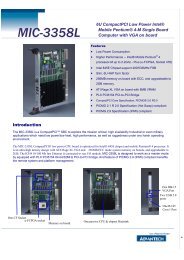industrial wireless book special edition - Networking ...
industrial wireless book special edition - Networking ...
industrial wireless book special edition - Networking ...
Create successful ePaper yourself
Turn your PDF publications into a flip-book with our unique Google optimized e-Paper software.
efficacy of a CBTC system is highly contingent<br />
on the communications response time. With realtime<br />
response, the CBTC can safely and efficiently<br />
maximise the number of trains on the track.<br />
In particular, communications must be sufficiently<br />
resilient to overcome the unique hazards<br />
of rolling stock operations - weather, shock,<br />
vibration and electromagnetic interference. The<br />
EN50155 and EN50121-1/2 standards are useful<br />
benchmarks for confirming that the communications<br />
devices are sufficiently robust for<br />
onboard and trackside applications.<br />
WLAN provides an answer<br />
WLAN (Fig. 1) offers an optimal combination of<br />
bandwidth and cost-effectiveness for railway<br />
operations. Wireless technology frees operators<br />
from the limitations and complications of<br />
cabling a communications system, which is a<br />
particularly arduous task in an application with<br />
as many moving parts as a train system. Of all<br />
currently available solutions, WLAN stands out<br />
as the solution with the best balance of capabilities<br />
and cost – see Table 1.<br />
As Table 1 shows, WLAN is clearly the superior<br />
choice, as it offers the most bandwidth and the<br />
lowest total cost. Monthly service charges are<br />
a significant continuing expense of satellite and<br />
cellular communications. With WLAN, not only<br />
are the installation costs low, but there is also<br />
no need to pay a satellite or cellular provider<br />
for data service. In terms of mobility, the development<br />
of optimised roaming technology has<br />
made WLAN mobile enough to support train to<br />
ground communications, even at relatively high<br />
cruising speeds.<br />
Trackside communications<br />
WLAN eliminates cabling headaches for trackside<br />
networks, such as theft, maintenance and<br />
damage. Trackside networks consist of numerous<br />
wayside cabinets that share data up and down<br />
a length of track. Replacing the cables with<br />
WLAN units in each wayside cabinet eliminates<br />
such vulnerabilities.<br />
Intra-train communications<br />
Compared with couplers, WLAN has a higher<br />
throughput and lower maintenance costs. Train<br />
operators are calling upon intra-train networks<br />
to support more applications, including<br />
passenger information, public announcement,<br />
Fig. 3. The antenna remains within 20cm of the<br />
waveguide strip on the ground. This helps provide an<br />
even more secure link between client and AP<br />
sponsored by Advantech<br />
<strong>industrial</strong> ethernet <strong>book</strong><br />
Fig. 2. Dual RF for <strong>wireless</strong><br />
redundancy – concurrent redundant<br />
<strong>wireless</strong> connections. Hardened<br />
outdoor <strong>wireless</strong> APs with fast<br />
roaming and dual RF redundancy<br />
are ideal for train to ground<br />
communications, e<strong>special</strong>ly when<br />
deployed with a high AP density<br />
video surveillance, intercom, HVAC, and datadriven<br />
train control systems.<br />
Conventional wired intra-train communications<br />
relied on couplers between carriages to send<br />
data down the line, but these have a fixed<br />
bandwidth and limited data rate, which places<br />
severe constraints on the upgradeability of an<br />
intra-train network. WLAN is a natural fit for<br />
intra-train networks that can reduce maintenance<br />
costs while increasing throughput to<br />
support more applications today and in the<br />
future. WLAN can comfortably support advanced<br />
CBTC and passenger infotainment systems.<br />
Train to ground communications<br />
As the key link between the trackside network<br />
infrastructure and the intra-train network, trainto-ground<br />
communications is the lynchpin that<br />
enables innovative, next-generation railway<br />
applications such as rich passenger infotainment<br />
systems and Automatic Train Operations<br />
(ATO) through CBTC.<br />
These systems simply would not be possible<br />
with conventional train-to-ground communications<br />
systems. ATO coordinates trains to<br />
maximise track utilisation and increase the<br />
service efficiency and frequency beyond that<br />
which is possible without central control. In<br />
order to safely do this, the control centre must<br />
receive and send a dizzying amount of data,<br />
including train status, passenger status, video<br />
data from cameras, and emergency controls. In<br />
addition, the Passenger Infotainment System<br />
must transfer real-time video, ads, news content,<br />
and more. 10 Mbps (or greater) is a reasonable<br />
estimate of how much throughput is needed to<br />
sustain these next-generation applications.<br />
The sheer magnitude of throughput required<br />
is far beyond radio capabilities. This level of<br />
demand even strains the capacity of modern<br />
satellite and cellular data technology such as<br />
GSM and HSDPA. However, the IEEE 802.11<br />
WLAN standard allows transfer up to 300 Mbits<br />
of data to comfortably enable all the applications<br />
envisioned today, with plenty of<br />
throughput left for future applications.<br />
Train-to-ground communications<br />
A reliable and capable train-to-ground communications<br />
link is the foundation of many valuable<br />
next-generation train systems, but creating such<br />
a link can seem like a daunting task. How is it<br />
possible to maintain a consistent, uninterrupted<br />
link between fixed trackside access points and<br />
a quickly moving train that traverses many<br />
different operating environments? Luckily, WLAN<br />
technology has a large toolbox of solutions.<br />
Train tunnels are examples of clear environments<br />
having limited interference. Antennas are a costeffective<br />
coverage solution for this kind of<br />
environment.<br />
There is far more interference above ground,<br />
e<strong>special</strong>ly in busy urban areas. Still, WLANs can<br />
use a number of strategies to create networks<br />
that remain reliable in these conditions.<br />
Hardened outdoor <strong>wireless</strong> access points (APs)<br />
with fast roaming and dual RF redundancy are<br />
ideal for such a scenario, e<strong>special</strong>ly when<br />
deployed with high AP density. (Fig. 2).<br />
For truly exceptional operating environments,<br />
waveguides (Fig. 3) or leaky (leakage) coaxial<br />
cables (LCX) provide an even more secure link<br />
between client and AP, albeit at increased cost.<br />
A track lined with waveguides or LCX cables<br />
offers stable, interference-proof access.<br />
Suitable communications equipment includes<br />
<strong>industrial</strong> embedded computers, <strong>industrial</strong><br />
Ethernet switches and IP cameras with EN50155<br />
and EN50121-1/2 certification to confirm their<br />
resilience in harsh railway environments, and<br />
the rugged <strong>wireless</strong> devices to bring it all<br />
together. Gigabit bandwidth enables real-time<br />
performance for passenger comfort and security.<br />
Outdoors <strong>wireless</strong> AP/bridge/client devices<br />
should feature fast roaming technology, as well<br />
as the dependability provided by dual independent<br />
RF modules, power redundancy, and a<br />
weatherproof, dustproof, wide operating temperature<br />
design.<br />
With two such units at each wayside cabinet,<br />
a railway can replace trackside cabling and its<br />
attendant maintenance headaches with dual<br />
redundant RF links. Units can connect to a solarpowered<br />
POE switch that supports, for example,<br />
an IP camera and a third <strong>wireless</strong> device that<br />
acts a local <strong>wireless</strong> AP.<br />
Such a system can provide railway staff out in<br />
the field with convenient <strong>wireless</strong> access to<br />
system maintenance tools. Such equipment can<br />
also provide the foundation for a future train<br />
communications network with the addition of<br />
even more advanced <strong>wireless</strong> technology,<br />
complete with fast train-to-ground WLAN<br />
communications.<br />
Paul Hsu is Product Manager for Moxa’s Industrial<br />
Wireless Division<br />
First published in the <strong>industrial</strong> ethernet <strong>book</strong> June 2011<br />
Transportation<br />
17

















